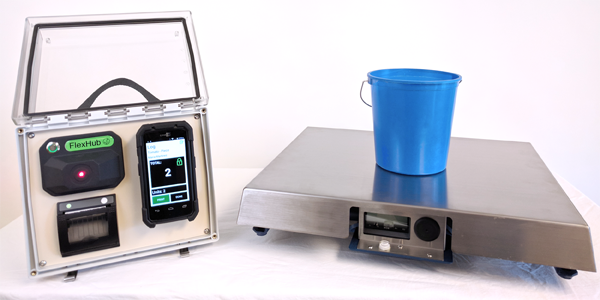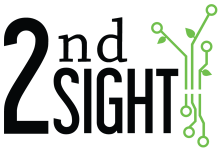Flexible Harvest Scale System for Hand-Picked Produce
Looking for a way to automate data entry, improve payroll accuracy, cut labor costs, and receive a quick ROI? Try 2nd Sight’s FairPick Flex, an electronic harvest scale package that offers growers increased labor data capture flexibility in addition to the same benefits as our FairPick mobile scale unit.
Forget the hassle of punch cards! FairPick Flex without the frame is perfect for growing operations where pickers stay in the same area or come to a central location to receive credit for produce picked. Read more, or contact us to learn why FairPick Flex is a better weigh to harvest!
Pickers always on the move? Purchase the rugged, mobile cart with your Lite system.

Included in the FairPick Flex Package
Ruggedized Handheld Computer (RHC)
Easy-to-use FairPick App
Robust, legal-for-trade, NTEP-certified scale
FlexHub with integrated thermal receipt printer and RFID reader
How it works
Manage tasks, containers, employees, piece rates, and other settings on your online Customer Portal. Use the Registration Station to assign employee badges (RFID cards). Before harvest begins, sync the RHC and select the appropraite container tare weights, variety, and location information on the FairPick app.
The FairPick Flex is a mobile time clock. Clock employees in and out to keep good records for minimum wage, non-productive, and paid break calculations. During harvest, the picker places a container on the weighing station scale platform. FairPick instructs the picker to scan his or her pre-assigned badge. In seconds, FairPick records precise weight, GPS location, time, variety, location, and optional container barcode. As a result, growers have full traceability and pay only for the exact weight of produce picked, not an estimate. The picker can print optional receipts after each weigh, and upon clocking out, receives a print-out with total weight picked for that day.package
The Weighing Process - Step by Step
Select crop and harvest information from custom lists on the app
Place filled container on the scale
Scan the employee's badge
Choose the appropriate container
Scan the container RFID tag or barcode (optional)
Remove the container
Print a picker receipt (optional)
It takes only seconds!
Traceability
FairPick Flex also meets increased industry and consumer demands for Traceability with the barcode container tracking feature.
Who: Scan employee RFID badges to identify each picker out in the field.
What: Scan container barcodes attached to bins and other harvesting containers to track what is picked.
Where: Built-in GPS links location with each logged event.
Farm Management
Year to year records to compare and inform future decisions
One-year ROI for many growers due to reduced labor costs
Cleaner bins with higher quality produce
GPS harvest yield data per field location
No more overpayments
Human Resources
Automated reports import into existing accounting and payroll software
Searchable, digital records quickly resolve pay disputes
Fair compensation reduces staff turnover
Accurate, streamlined payroll process
Minimal manual data entry
Field Operations
Quiet fields without picker arguments
Reduced puncher bottlenecks
Quick wireless data upload
No more guesswork
Cleaner bins
Legal Compliance
NTEP-certified, legal-for-trade, ruggedized Mettler-Toledo scale
Searchable, detailed, and organized digital records
Cloud data storage for long-term recordkeeping
Minimum wage report flags
Field receipts for workers
Safety
Adjustable-height scale for good ergonomics and safe lifting
Reduced bag or bucket weights minimize strain on workers
No need to climb ladders with partially filled containers
Traceability data for improved produce safety
Social distancing maintained in the field
In recent years, food born illness outbreaks have been linked to spinach, bagged salad, onions, peaches, romaine, and sprouts. When contaminated produce is detected by consumers and retailers, there is great value for the industry to be able to tell the full story of the affected product. Traceability systems can help maintain growers’ and processors’ reputations (curtailing negative consumer opinions about a particular crop), decrease the amount of produce inventory that will be discarded (minimizing waste and financial loss), and help with preventative measures that can be taken in the future. Produce tracking also helps keep consumers safe, reducing the number and gravity of food borne illness cases. When food tracking is poor, limited, or takes too long to "trace back" the product through the supply chain, the specialty crop industry as a whole suffers.
2nd Sight hardware and software packages focus on collecting farm labor data in the field. If an ounce of prevention is worth a pound of cure, field data is a critical piece of the traceability puzzle. While tracking labor data, our systems are also logging the first human contact with the fruits or vegetables. To stop contamination at the source, you must be able to identify the source.
- Date/time stamp: Every clock in, clock out, and log event is automatically tagged with a date and time so you know when employees performed specific jobs
- GPS: The handhelds register GPS coordinates, when available, every time the software logs an event to help pinpoint a field location
- Location: Growers can tag additional location information to specific jobs such as field name, block number, and row number
- Crew: Crew lists can aid in identifying groups of employees who may have been linked to a specific food safety concern
- Employee: Employees utilize RFID badges or barcodes programmed with their names to scan in and out of jobs and log pieces and produce harvested
- Container Tracking: Many apps feature container tracking modes that prompt employees to scan RFID tags or barcodes adhered to buckets, totes, or bins out in the field to link produce to pickers more precisely
- Digital Records: Quickly search and filter digital logs and reports by date, location, employee, crop variety, and container tracking ID to identify who, what, and where when produce safety issues arise
- Accessible Information: Data is secure and backed up on the Cloud and can be accessed through any computer connected to the Internet
Case Studies
Many blueberry and cherry growers in British Columbia, Canada received funding through the BC Traceability Grant program to help subsidize the cost of implementing 2nd Sight software and hardware because our systems improve produce traceability.
Contact us to learn more about how simple it is to get started at your farm. Start benefitting from improved labor tracking and produce tracking whether you pay by hours, by piece, or by weight.
Example Data Set
Do you grow produce in British Columbia, Canada?
Fruit & Vegetable Weighing Compatibility
- Apples
- Apricots
- Artichokes
- Asparagus
- Avocados
- Blackberries
- Blueberries
- Boysenberries
- Broccoli
- Cherries
- Cacao
- Cotton
- Figs
- Gooseberries
- Grapefruit
- Grapes
- Grape Leaves
- Huckleberries
- Kiwifruit
- Lemons
- Lettuce
- Limes
- Litchi
- Mango
- Nectarines
- Olives
- Oranges
- Peaches
- Pears
- Peppers
- Plums
- Raspberries
- Saffron
- Squash
- Strawberries
- Tangelos
- Tangerines
- Tea Leaves
- Tomatoes
- Zucchini
Container Weighing Compatibility
- Bags
- Baskets
- Boxes
- Buckets
- Clamshells
- Crates
- Flats
- Lugs
- Pails
- Totes
- Trays
Ruggedized Handheld Computer (RHC)
Ruggedized, portable computer that runs the FairTrak app.Features
- Water and drop-resistant design
- Robust, sunlight-readable LCD touch screen
- Integrated RFID and barcode scanner
- Cellular SIM card option for real-time data collection
- Charging dock (purchased separately)
FairPick App
Android-based app used to collect time clock and weigh data.Features
- High-contrast buttons and icons
- Customizable tasks, lists, and container information
- Automatic software updates from the Google Play Store
- Audio/visual indicators to assist pickers
- Multiple configurations to adapt to a variety of picking processes
Fruit & Vegetable Scale
Robust, legal-for-trade scale that connects and sends weight information to FairPick Lite App.Features
- 16.5” x 20.5” NTEP-certified scale
- 150 lb (68 kg) weighing capacity
- ± 0.01 lb (0.005 kg) accuracy
- Water-resistant
Employee Badge Registration Station
Office-based computer station used to program employee badges and RFID tagsFeatures
- Use your own Windows-based personal computer
- Plug the RFID Reader/Writer into any standard USB port
- Registration Station app download
FlexHub
Portable box that houses the receipt printer, external RFID reader, and battery that integrates with the RHC and scale.Features
- Thermal receipt printer for picker receipts
- External RFID reader for quick badge scanning
- Sleek and sturdy design
- Integrates wtih other 2nd Sight products
Customer Portal
User-friendly website where growers manage employees, containers, piece rates, uploaded data, reports, and other harvest settingsFeatures
- Import employee lists to save time
- Create Employee Profiles to track minimum wage and break information
- Add multiple container tare weights or set to use individual tare weights
- Turn container RFID tag tracking on and off
- Set and change piece rates per container
- Enter a minimum scan time between weighs to prevent "double-scanning"
- Add additional Portal users with different admin roles
- Easily filter data
- Set the Pay Period to weekly, bi-weekly, or monthly beginning on any day of the week
- View standard and custom reports and download them in CSV format
- Edit, add, and delete data while maintaining a clear audit trail
 English
English  Español
Español 

